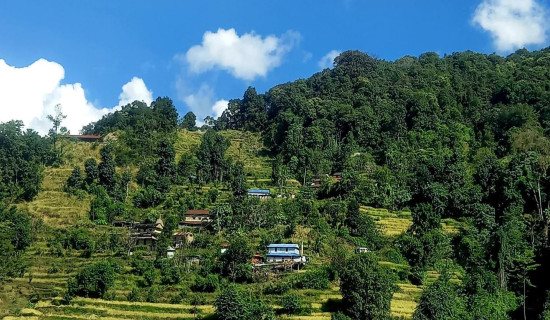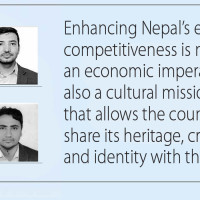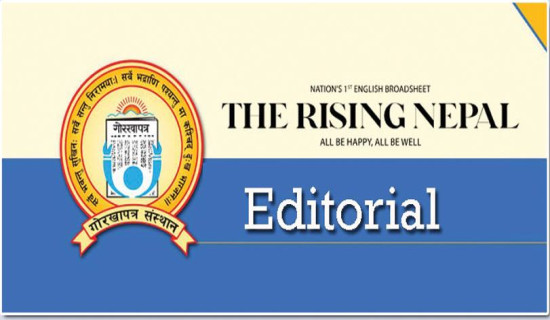- Tuesday, 11 November 2025
Leveraging Festival’s Power To Heal Wounds
We are a few days into the great festival of Dashain. Normally, it is a time when every sleepy town and village comes to life as if it were jolted by an electric shock. However, for the past five years, a series of sobering events has cast a pall over the festival. In 2020, it was the COVID-19 pandemic. The blow it dealt nearly every sector, including businesses, was so severe that they struggled to return to their feet in the following years. In 2022, the outbreak of the Russia-Ukraine conflict spiked inflation and added to people’s hardship by making daily essentials unaffordable. These effects rippled in 2023. Then, in 2024, came the devastating floods and landslides on the eve of the festival that left hundreds dead and wreaked havoc nationwide.
Then, this year, as Nepalis – at home and abroad – were gearing up for the festival, abhorrent acts of violence – unleashed by the ‘infiltrators’ in the Gen Z movement – have caused the catastrophic destruction of lives and properties. What is profoundly heartbreaking is the lives of innocents cut short in the police firing. This has surely plunged the entire village or town into mourning in many places. Only justice will bring solace to the devastated families who lost their loved ones. Weeks later, many continue wondering why the businesses that took immense risks to create tens of thousands of jobs, to contribute significantly to the nation’s development and prosperity, and are a reliable tax base for the government were targeted.
There can never be a justification for the despicable acts of arson or vandalism bent on destroying living pieces of history or structures from where justice is served and people’s rights are protected. On the sunny side, no matter how deep the loss might seem, it can be managed with the inner strength inherent to all of us. Dashain is a uniting force in every foreign country where Nepalis constitute a sizeable population, rallying them under one shared identity. This unified identity is crucial to healing the wounded country and rebuilding the destroyed iconic government structures and private properties.
There have been accusations that the widespread arson and looting spree across commercial properties was sparked by jealousy and envy. This argument holds water to some extent because they stood as a symbol of success. This achievement not only breeds further success but also antipathy and resentment from their rivals. One hard lesson to be learnt from these events is how fragile peace and progress can be when destructive tendencies within us are allowed to run amok and how crucial it is to cultivate noble qualities to keep them from taking over our consciousness. Indeed, what we harbour inside plays outside.
While the festival originates in the legendary victory of Lord Ram over the demon king Ravan and Goddess Durga over the demon Mahisashur, its essence is the triumph of the good over the evil within us. It emphasises surrendering to the divine and shedding negative tendencies, aligning with the cosmic order and universal forces. The battle fought outside is representative of the inner battles we all face inside. Once the force of darkness within us is overcome, it paves the way for spiritual transformation. Getting away with the negative tendencies that harm us and those who come in contact with us lies at the heart of this transformation.
Examples abound that festivals can play a pivotal role in rebuilding nations and healing the psychological wounds of a traumatised population left by the profound social upheaval. They strengthen the social, cultural, and emotional foundations that unite people with a common identity.
Rwanda’s Umuganura Festival, celebrated as a thanksgiving for a good harvest, became a platform for unity after the 1994 genocide. Festive celebrations create moments of joy crucial for boosting mental health.
Most of all, a great festival restores community bonds, bringing people together. Though they cannot build things by themselves, they can rebuilt the indomitable human spirit and consolidate social cohesion, which can serve as an essential starting point to build back better. In a heartening display of this spirit, the businesses that had their properties gutted have vowed to rise again from the ashes to their former glory and continue to create jobs and serve communities, boding well for the recovery.
It is customary across India and some parts of Nepal to burn the effigy of the demon king Ravan to celebrate the festival. Let us burn down demonic tendencies within us so that the divine qualities humans are uniquely endowed with are revealed. This inner purification is central to the message of this festival, which encourages us to examine our lives and defeat the negative tendencies that impede our spiritual growth. It is a reminder that true victory lies in the internal mastery of the self, and not in external conquests.
Dashain also holds a special significance in the cycle of nature. Celebrated at the transition between seasons, it mirrors the cosmic law of cycles, change, and renewal.
Nature shedding its old order calls us to shed layers of our old self that serve us longer. This shedding is essential to create space for new wisdom, clarity, and purity. While the festival is increasingly associated with shopping, too much focus on superficiality numbs our innate sense that life is too precious to waste in materialistic consumption.
(Basyal is a journalist at The Rising Nepal.)





-square-thumb.jpg)




-original-thumb.jpg)



